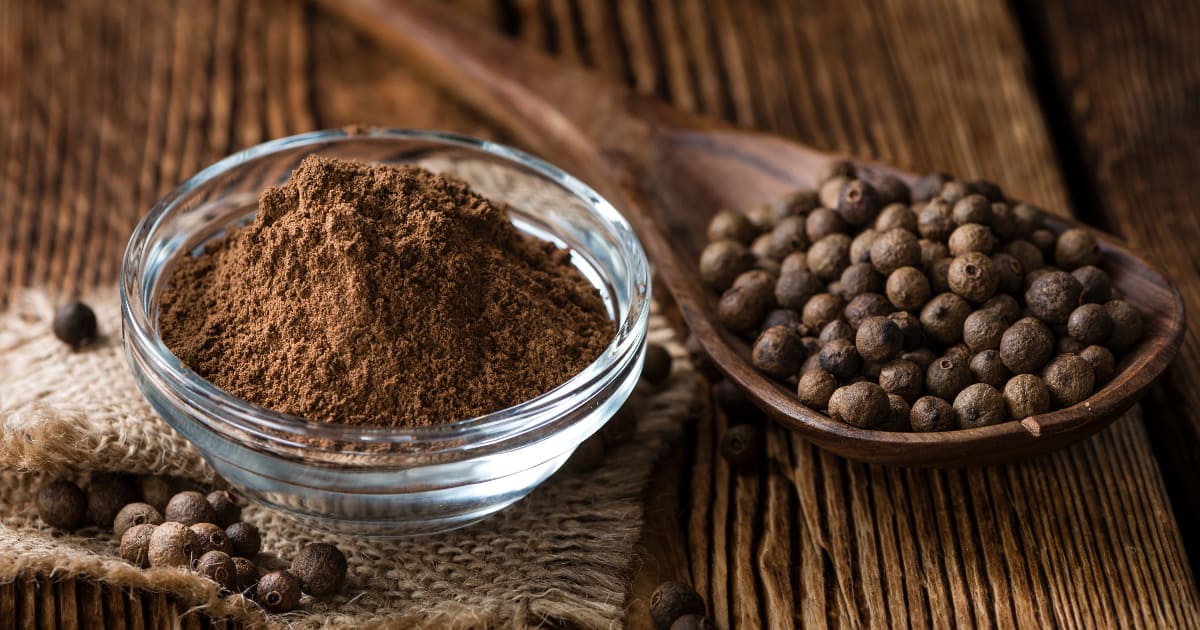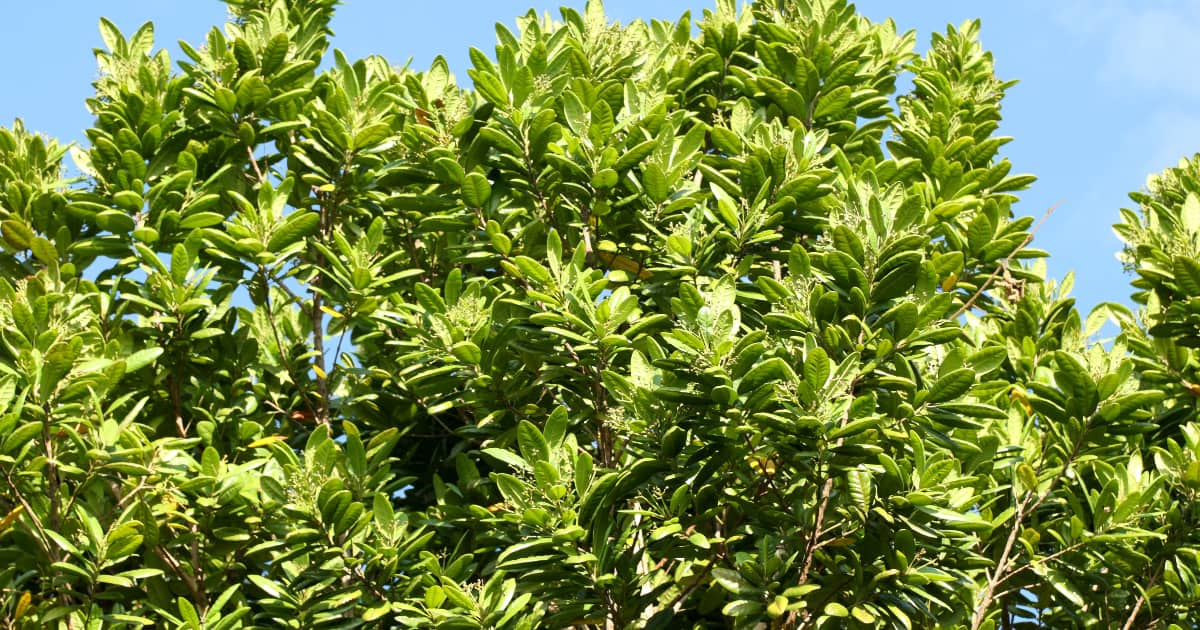Allspice powder is a versatile and flavorful spice that comes from the dried berries of the Pimenta dioica tree. This aromatic spice has a complex flavor profile reminiscent of a combination of cinnamon, cloves, nutmeg, and black pepper.

Although its name may imply that it is a blend of multiple spices, allspice is actually derived from just one plant. The rich and nuanced taste of allspice powder makes it a staple ingredient in many global cuisines. It adds warmth, depth, and complexity to both sweet and savory dishes.
Key Takeaway: Allspice powder comes from the dried fruit of a single plant and has a taste reminiscent of cinnamon, cloves, nutmeg and black pepper. It is used in cuisines worldwide.
The Origins and History of Allspice
The allspice tree is indigenous to the Greater Antilles islands of the Caribbean, particularly Jamaica. The Spanish were the first Europeans to encounter allspice upon arriving in the New World. In the 16th century, Spanish explorers brought allspice back to Europe, where it became known as "Jamaican pepper."
Allspice was given its English name in the 17th century when the British noted that its complex flavor seemed to encapsulate the tastes of cinnamon, cloves, nutmeg, and pepper in one spice. The name stuck, even though allspice comes from just one plant.
Throughout history, allspice has been an important trade good. Historic maritime powers like Spain, Portugal, and England controlled the valuable allspice trade routes for centuries. Today, Jamaica remains one of the world's major producers and exporters of allspice.
Key Takeaway: Allspice originated in the Caribbean and was an important historic trade good controlled by European colonial powers. Jamaica remains a major global source today.
How Allspice Powder Is Made

Allspice powder begins with the fruit of the tropical Pimenta dioica tree. The tree produces small green berries that are picked by hand when unripe. The berries are then cured through a process of fermentation and sun-drying, which turns them into the dark brown color we associate with allspice.
Once fully dried, the allspice berries are ready to be ground into powder. The grinding process simply crushes the brittle berries into a fine powder. Allspice powder has a medium brown color and a strong, sweet aroma. It provides an assertive allspice flavor but without the textural effect of using whole berries.
Key Takeaway: Allspice powder is made by picking unripe allspice berries, curing them, drying them completely, then grinding the dried berries into a powder.
The Versatile Flavor Profile of Allspice Powder
The taste of allspice powder is multifaceted and complex thanks to its essential oil content. The flavor combines notes of clove, cinnamon, black pepper, and nutmeg, with hints of cardamom, juniper, and even vanilla.
Allspice has a warm, sweet, and somewhat peppery taste. It provides a gentle heat along with notes of fruit and wood. The nuanced flavor profile makes allspice extremely versatile in both sweet and savory dishes.
While its name may suggest it is a "blend" of spices, allspice powder truly encapsulates an entire spice flavor experience in one ingredient. No wonder it has been prized by cooks around the world for centuries!
Key Takeaway: Allspice powder has a complex, nuanced flavor combining cinnamon, clove, pepper and nutmeg notes that make it versatile in both sweet and savory recipes.
How to Select and Store Allspice Powder
When shopping for allspice powder, look for it in the spice aisle at well-stocked grocery stores or spice specialty shops. Be sure to check the expiration date and choose packages without signs of moisture or clumping. Allspice powder should have an even, medium-brown color.
For optimal freshness and flavor, store allspice powder in an airtight container in a cool, dark place. Keep away from direct light and heat. Stored properly in a dry environment, ground allspice will keep for 2-3 years before losing potency.
Key Takeaway: Look for non-clumping allspice powder sold in moisture-proof packaging, and store it in an airtight container in a cool, dark place to preserve freshness.
Culinary Uses for Allspice Powder
Allspice powder is a flexible ingredient used around the world to add warmth and dimension to both sweet and savory recipes. Here are some of the most popular ways to use it:
- Baked goods: Allspice is excellent in cookies, cakes, muffins, bread and pastries. It is a key spice in gingerbread, pumpkin pie, and spice cake.
- Fruit dishes: Allspice pairs well with fruits like apples, pears, plums, peaches, and berries. Use it in fruit crisps, compotes, jams, or chutneys.
- Savory proteins: Rub allspice on chicken, pork, lamb, or fish before roasting or grilling. It is great in marinades, stews, clam chowder and soups.
- Root vegetables: Allspice brings warmth to potatoes, sweet potatoes, carrots, squash, and pumpkin.
- Beverages: Add allspice to mulled wine, warm apple cider, coffee, and tea blends. It's an ingredient in chai tea.
With its diversity of flavors, allspice powder truly livens up both sweet and savory recipes from breakfast through dessert!
Key Takeaway: Allspice powder can be used in baked goods, with fruit, on proteins, with root vegetables, and in beverages for a touch of warmth and dimension.
Popular National and Regional Cuisines Featuring Allspice
Allspice powder is used in traditional cuisines across the globe. Here are some national and regional cuisines where it plays a starring role:
- Jamaican: Allspice is an essential ingredient in Jamaican jerk seasoning blends for meat. It also flavors stews, rice dishes, and baked treats.
- Cajun/Creole: Allspice adds depth to dishes like jambalaya, gumbo, shrimp Creole, dirty rice, red beans, and rice.
- Middle Eastern: Allspice is combined with lamb, used in tagines and pilafs, and added to spice blends like baharat.
- Indian: Allspice is used in garam masala blends and to flavor-rich, meaty curries and dry rubs for tandoori chicken.
- Latin American: Allspice is popular in mole sauces, rice dishes, and meat preparations, as well as in desserts and drinks.
- Caribbean: Caribbean cuisine uses allspice across islands in jerk dishes, stews, curries, and to flavor rum cakes and banana breads.
No matter where allspice powder originated, it has clearly become a global sensation loved by cooks worldwide.
Key Takeaway: Allspice is essential in Jamaican, Cajun, Middle Eastern, Indian, Latin American and Caribbean cuisines, where it adds depth and smoky warmth.
Substitute for Allspice Powder
Don't have allspice powder on hand? You can approximate the flavor by making your own DIY "allspice" blend at home with common spices.
To make a quick allspice substitute, combine:
- 1 teaspoon ground cinnamon
- 1/2 teaspoon ground cloves
- 1/2 teaspoon ground nutmeg
- 1/4 teaspoon ground ginger
You can adjust the proportions to tweak the flavor balance as needed. Other possible additions include black pepper, mace, cardamom pods and star anise, all of which complement allspice's flavor profile.
While this homemade blend won't perfectly mimic the complex flavor of true allspice powder, in a pinch it will provide a similar warm, aromatic and slightly spicy taste.
Key Takeaway: Make an allspice powder substitute by combining cinnamon, cloves, nutmeg and ginger in approximate proportions.
FAQ
Is allspice powder spicy hot?
Allspice powder provides warmth but is not spicy hot. It has a gentle, peppery heat but does not contain capsaicin like chili peppers. The warmth comes mainly from essential oils like eugenol.
What's the difference between allspice and pumpkin pie spice?
Pumpkin pie spice is a blend that typically contains cinnamon, ginger, nutmeg and allspice. Allspice powder contains flavor notes of all those spices in one ingredient. Pumpkin pie spice relies on allspice powder as one of its components.
Does allspice go bad?
Ground allspice powder will eventually lose potency over 2-3 years but does not actually expire or go bad. To extend shelf life, store in an airtight container away from light and heat. For the freshest, most flavorful allspice, try to use within 12-18 months.
Can you use whole allspice instead of the ground?
Whole allspice berries can be substituted for ground powder, but the flavor will be slightly mellower. Use about 1/4-1/2 teaspoon of freshly crushed berries per teaspoon of ground powder called for. Remove whole berries before eating.
Key Takeaway: Allspice powder provides gentle warmth, differs from pumpkin pie spice blend, lasts 2-3 years stored properly, and can be substituted with freshly crushed whole berries.
Conclusion
With its complex medley of flavors and aromas, it's no wonder allspice has earned a place in cuisines across the globe. The dried berries of the allspice tree add notes of cinnamon, cloves, pepper, and other spices that add incredible depth and dimension to both sweet and savory recipes.
Allspice powder is easy to find at the grocery store and will keep for years in an airtight container away from light and heat. With just one simple ingredient, you can inject warm, subtle flavor into baked goods, fruits, proteins, vegetables, beverages, and more. Experiment with allspice powder to give your favorite dishes a uniquely global flair.

